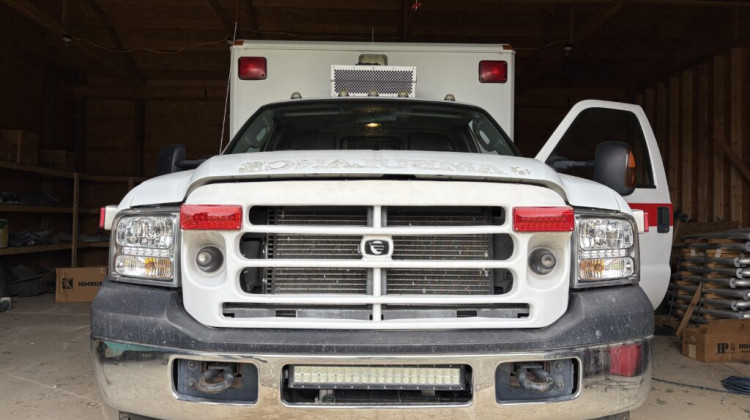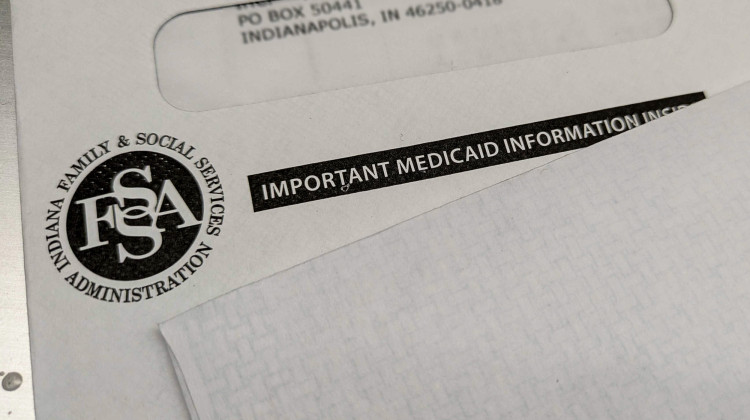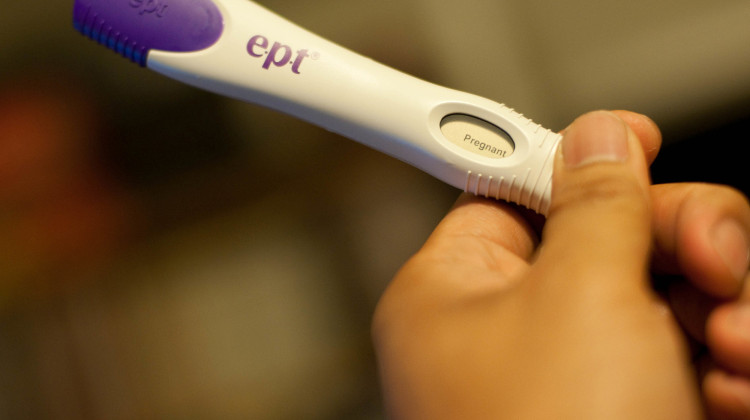
David, Allison and their sons Phil and Daniel are finally enjoying some sort of normalcy after months of stress.
(Farah Yousry/Side Effects Public Media)Seven-year-old Phil Will still recognizes where the tape that split his house into two sides was glued to the ground. The kitchen and shelves where his mom stores board games were on one side, and the staircase leading to the basement was on the other side.
That tape stayed there for more than four months before his parents ripped it off. It did not leave much of an imprint on the ground, but it left a big one on Phil’s mental health.
In March 2020, when most people felt a knot in their stomach as they watched COVID-19 news coverage, Phil had a front row seat to the pandemic’s most uncertain and scariest moments, because his dad is a doctor at a hospital in Indianapolis.
Studies have shown that the pandemic has taken a toll on children’s mental health across the U.S. The American Academy of Pediatrics, American Academy of Child and Adolescent Psychiatry and Children’s Hospital Association have declared a national state of emergency in children’s mental health tied to the pandemic.
But not every child was introduced to COVID in the same way. For children of health care workers like Phil, the pandemic was more vivid than many could fathom. In a way, he was introduced to the most eerie and mysterious version of the virus — and he internalized that, his dad said.
Phil’s dad, Dr. Dave Will, is a hospitalist at Franciscan Health in Indianapolis. His smartphone photo app is a colorful grid made up of funny photos of Phil and his younger brother and a handful of selfies from the hospital.
One photo stands out to him.

“That was right outside the room of the first COVID patient we saw in the hospital,” Dave said as he pointed to a selfie of him wearing a polypropylene gown and a N-95 mask snugly strapped over his mouth and nose.
It was one of the earliest COVID cases in the state. Dave was face-to-face with a mysterious and deadly virus at a time when testing for the virus was a logistical feat.
“We had to send the labs to a special lab in Arizona to get tested. It took six or seven days, so we did not know for six or seven days,” he said. “We were like, it looks like COVID, but we are just not sure yet.”
Suddenly, Dave was unsure if he could embrace his kids or wife of 13 years.
So that’s when he and his wife, Allison, decided it was best to divide the house into two using tape on the ground and have Dave live in the furnished basement, away from the rest of the family. Allison, a stay-at-home mom, has Type 1 diabetes, which puts her at greater risk of health complications if she gets COVID. That heightened everyone’s fears, including Phil’s, who was then 5 years old.
“It was hard, especially for the kids, because actually, at our hallway from our garage to the rest of the house, we put a tape line down to help the kids know not to come running to dad,” Allison said.
They needed to do a lot of explaining to the kids — how their dad is in the same room everyday with patients who have a dangerous virus, how he might seem healthy and not show any symptoms but “could still give it to you”.
Allison said she would often stand at the top of the staircase while Dave sat at the bottom and they’d just chat.
“Sometimes I want to go down and give him a hug. I’m like I want to reassure you but I don’t know how,” she recalled. “This is a medical emergency; I want to say everything will be alright, but I just don’t know that.”
Dave said this experience made him appreciate the military even more. Although he still lived in the same house, he felt like he was far away. The difference was that at times it felt like he could be bringing battlefield grenades inside his home.
The kids and Allison lived separated from Dave for a total of 16 weeks.

Stress and anxiety can be worse for health care workers’ children
Phil was old enough to understand what was going on at the time, and in his words, “COVID is the worst”. Before he was vaccinated, he said, he “was really, really, really scared”.
Phil may be too young to articulate the depth of his feelings. But when school was back in-person, it was clear this front row experience to the pandemic had left some scars.
“Phil would actually kind of have, like almost panic attacks, anxiety attacks at school,” Allison said. “So his teachers and some of the teacher aides at school would kind of get him out of the classroom and kind of help him through these episodes and even calling me or FaceTiming me at school to try to help him just kind of calm down.”
A prospective study conducted in Turkey and published in the journal Clinical Child Psychology and Psychiatry looked at the depression and anxiety levels of children of health care workers compared to children of similar age and gender of non-health care workers during the pandemic. It found that Children’s Depression Inventory or CDI score — a measurement of the severity of depressive symptoms — were elevated but nearly similar in both groups. But it also found that the children of health care workers had noticeably higher State-Trait Anxiety Inventory or STAI-C scores — a measurement of anxiety levels in children.
The study concluded that because of the high-risk environment that health care workers have been in during the pandemic, their children “may be at greater psychological risk than other children”.
Dave and Allison’s own stress and anxiety levels were also sky high at that time. And that inadvertently may have transferred to the kids.
Another recent study found a strong link between the mental health of parents or caregivers and a child's mental health and development. A survey by Mental Health America conducted between June and September 2020 found that 93 percent of health care workers reported experiencing stress and 86 percent reported anxiety. Of the main stressors were exposing loved ones to the virus and struggling with parenting.
Getting back to normal

The pandemic is not over yet, but with more information about the virus and vaccine and treatment availability, things have started to get closer to normal at the Will family house. Even though Dave still sees COVID patients, the tape that once divided the house has never had to return, and stress levels for everyone are much lower.
Phil’s anxiety has also dissipated after receiving his vaccine and undergoing aa few months of therapy sessions.
Dave can now sit at the dining table holding Allison's hand while Phil and his 3-year-old brother run around with colorful lego sculptures in their hands.
Dave said the only silver lining coming out of this is how much more he cherishes time with his wife and kids. And in a way, he said, it made him a better, more present parent.
“We play a lot more board games, we go outside, we've gone on camping trips, we bought a canoe and we've gone on some canoe trips. You know, you just take a lot less for granted,” Dave said. “You don't know how much time you have with them. And so the time you spend is, I think, higher quality. And so I've been grateful in that sense that that was a bit of an eye opener.”
This story comes from a reporting collaboration that includes the Indianapolis Recorder and Side Effects Public Media — a public health news initiative based at WFYI. Follow Farah on Twitter: @Farah_Yousrym.
9(MDAyMzk1MzA4MDE2MjY3OTY1MjM5ZDJjYQ000))
 DONATE
DONATE






 Support WFYI. We can't do it without you.
Support WFYI. We can't do it without you.